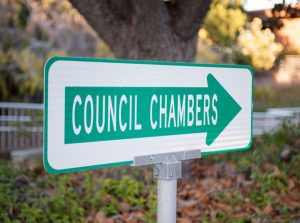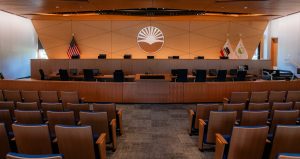Santa Clarans will decide whether to amend the charter in March, determining if the City is to be split into three districts with two Council Members each.
At Tuesday night’s meeting, City Clerk Hosam Haggag introduced the Council to the language in a ballot measure that will govern the next two elections.
The measure asks voters whether Santa Clara should, in 2020, elect the Council in a six-district format — as it did earlier this year because of court mandates due to the City losing a California Voting Rights Act (CVRA) case — then move to a three-district format with two Council Members in each district in 2022.
While the City appeals the CVRA decision, the Council assembled a Charter Review Committee to establish how best to amend the charter. The Council previously accepted all that committee’s recommendations, but the unveiling of the ballot language dredged up disagreement.
Wesley K. Mukoyama, who brought the CVRA lawsuit against the City, said the proposed ballot measure would cause more litigation, stating that he believes it does not alleviate the issue of racially polarized voting in Santa Clara, the reason for the CVRA lawsuit.
Further, he called into question Haggag’s involvement in the charter review process, pointing the finger at him because Haggag was a proponent of the failed Measure A — a 2018 ballot initiative to split the City into two districts and establish ranked choice voting — before he was Clerk.
“It sounds like the fox in the chicken coop to me,” Mukoyama said.
Another resident, Victoria Smith, said the City is “itching for a fight” by proposing three districts.
Proponents of the three-district option point to residents’ ability to vote in every election, something public outreach showed Santa Clarans like. However, others say the Charter Review Committee and Council ignored the results of an online survey that showed more than two-thirds of residents prefer six districts.
Still, supporters of the three-district solution, which included Mayor Lisa Gillmor and Council Members Debi Davis and Kathy Watanabe, cited the survey’s inability to track traffic. Respondents could cast as many votes as they wanted. Instead, proponents relied more on other methods of gauging public opinion, such as in-person surveys.
The goal of six districts, many said, is to make running for Council more accessible by creating smaller districts.
Anthony Becker, who had unsuccessful vies for Council against Watanabe and Gillmor, compared the Council’s insistence on creating three districts to a state defying the Supreme Court’s decision to end segregation. That the Council ignored the survey, he said, was a “red flag,” calling three districts “backtracking.”
By creating smaller districts, Becker said, the Council would ensure candidates didn’t get “beat by finances” like he did.
“It is all about who you know in your neighborhood, not about who you know in City Hall,” he said.
With regard to the survey, Davis countered, saying that “data can be manipulated.” She, and others, rejected the notion that the CVRA ruling accurately describes the City.
“There is no polarization in our city,” she said. “It does not exist.”
Kevin Park, a Santa Clara resident, said Charter Review Committee members were “focused on getting one result.” He said it was as if “a lot of these decisions, a lot of these discussions were already predetermined.”
Late in the discussion, Vice Mayor Patricia Mahan, in the interest of “transparency,” proposed splitting the two issues, saying she feared residents who want six districts in 2020 but do not want three districts in 2022 would be caught in a tough position.
“They are two different questions,” she said. “I don’t see why they are tied together.”
Despite concerns from Mahan and Council Member Karen Hardy, the Council approved the ballot initiative in a 4-2 vote. The initiative will appear on March 2020 ballot, and will govern how the November 2020 election plays out. Council Member Raj Chahal was absent.
Well Issue Spurs Criticism of Student Housing Development
In other Council business, a seemingly routine consent calendar item evolved into a public debate about the merits of a proposed student housing development.
Discussion surrounding the renewal of an exclusive negotiating agreement between the City and developer Republic Metropolitan began when Davis pulled the item from the consent calendar. The issue of relocating a well on the property, located at 500 Benton St., and the intent to dig another well later, has delayed the project.
Davis accused the developer of “dragging their feet.”
Robert Mezzetti, an attorney for Republic Metropolitan, rebuked Davis’ accusation, saying his client is committed to working with the City toward an amenable solution.
Opening the door on the item prompted more than 20 members of the public to address the Council, both decrying the development and praising it.
Several members of the Old Quad Resident Association — who frequently air their concerns about the fallout from student housing near single-family neighborhoods — opposed the development, despite, as many said, it would “alleviate a lot of stress” on their neighborhood.
The development is billed as “quality market-rate housing” even though it is leased by the bed. The City owns 70 percent of the property and Valley Transit Authority (VTA) owns 30 percent.
Many argued that the housing project does not take full advantage of its proximity to the transit center.
Rob Mayer, an architect and resident of Santa Clara, said transit-adjacent housing should be the “face of the City.
“Maybe we need to rethink what happens here, so it is truly a destination,” he said. “It is a little cart-before-the-horse.”
Mahan said painting all students with the same brush “denigrates” them, adding that students are a “key element” in revitalizing the City’s downtown. She called the project a “step in the right direction.”
Gillmor extended an olive branch, saying that the delay cannot solely be laid at the feet of the developer. The City and VTA also bear some responsibility, she said.
The Council unanimously passed extending the exclusive negotiating agreement with the provision that City employees report back to the Council in 120 days on the status of the situation with the well.
Next Phase of Fee Schedule Moves Forward
The Council also approved phase two of the municipal fee schedule and updated the fire and building codes.
The phase two fee schedule aims to whittle the City’s $22.4 million subsidy of City services by striving for higher degrees of cost recovery in select departments.
Although many fees are increasing, Kenn Lee, the City’s Finance Director, said cost recovery for Santa Clara is still considerably lower than most cities in the area.
Community room fees were omitted from phase two and will be discussed during a Dec. 17 study session. The City deleted 32 fees but added 83 new fees, mostly to services that had previously been free.
Robert Fitch, a resident, said such fee schedules are unfair since the City already taxes residents. Those taxes are supposed to be for City services.
“Cost recovery, to me, is a dangerous temptation, because it looks good, but it is really double counting,” he said.
Council Says ‘Yes’ To One Collaboration with Neighbors, Nixes Another
A study of Stevens Creek Boulevard that involves the City working with Cupertino and San Jose gained traction.
Craig Mobeck, Director of Public Works, said the study focuses on “high-transit, multimodal, complete streets” areas.
“We are so gridlocked. It is ridiculous,” said Davis.
Another collaborative effort, this one with San Jose, saw little support because of it vagueness. A so-called “innovation zone,” which would include areas of Santa Clara along Stevens Creek Boulevard, failed to garner Council support.
Council Member Teresa O’Neill brought the ill-defined concept to the Council in “an attempt to work together with San Jose [to] look at new technologies.”
Despite the well-meaning intentions of the designation, the Council pushed back because of how fuzzy the parameters of the idea were, including its funding source and what it entailed.
Davis described it as “not a priority,” while Hardy said “I desperately want to like it.”
“This is my district and I don’t think they want anything happening in there right now,” Davis said. “We already have enough going on … They are already complaining about the shuttle buses going through there.”
Gillmor said she never received information she requested from San Jose Council Members.
Consent Calendar Items, Electric Costs Increase
The Council also appropriated up to $90,000 in matching funds to secure a grant that would rehab Agnews Park. Another $189,000 was awarded to Arrow Fencing for “street corporation yard electric gate project.”
Silicon Valley Power (SVP) increased its rate by 3 percent. That increase amounts to an additional $1.50/month for the average residential customer. SVP’s rates are 49 percent lower than PG&E.
The Council meets again Tuesday, Dec. 3 in the Council Chambers at City Hall, 1500 Warburton Ave. in Santa Clara.












0 comments